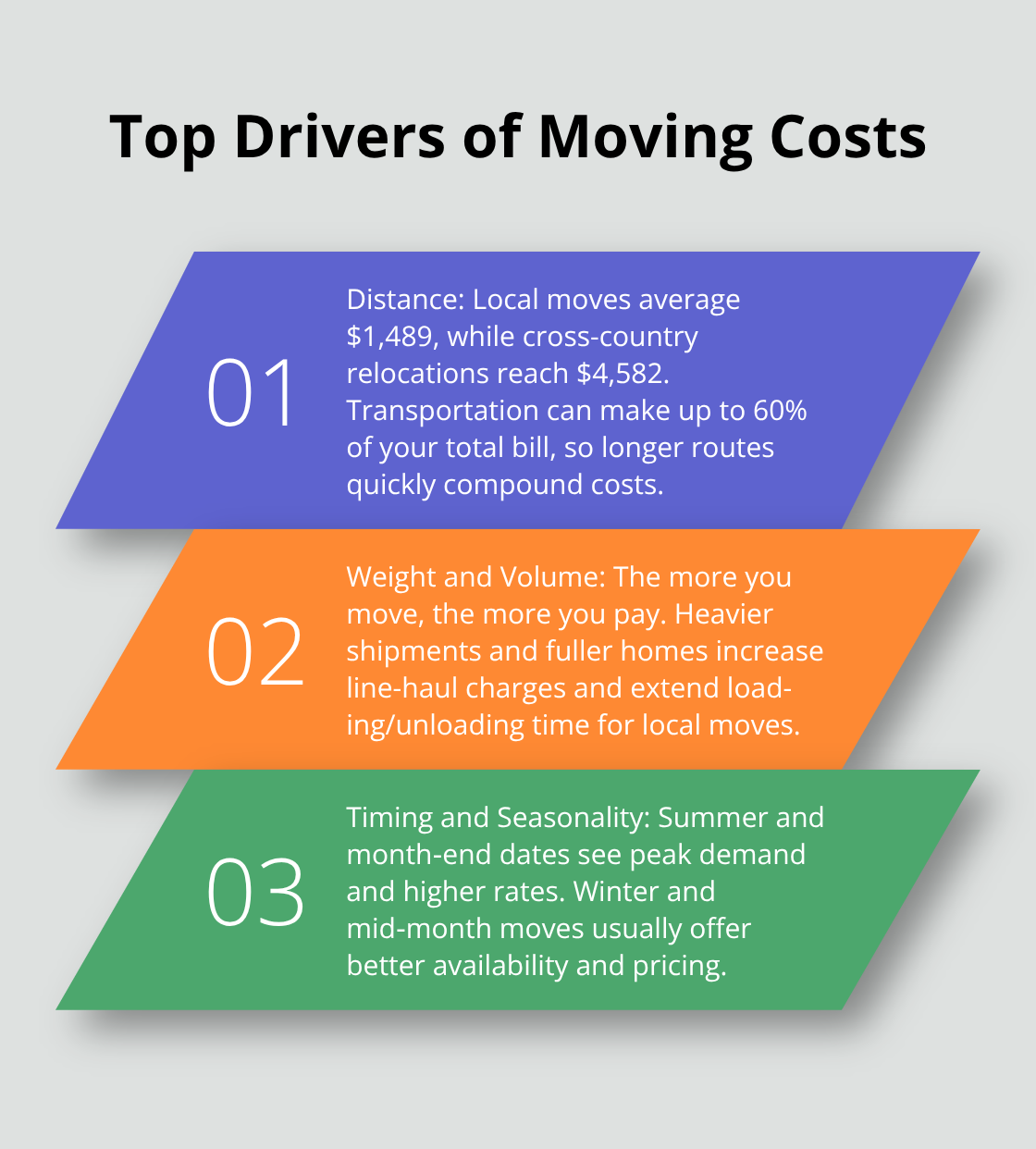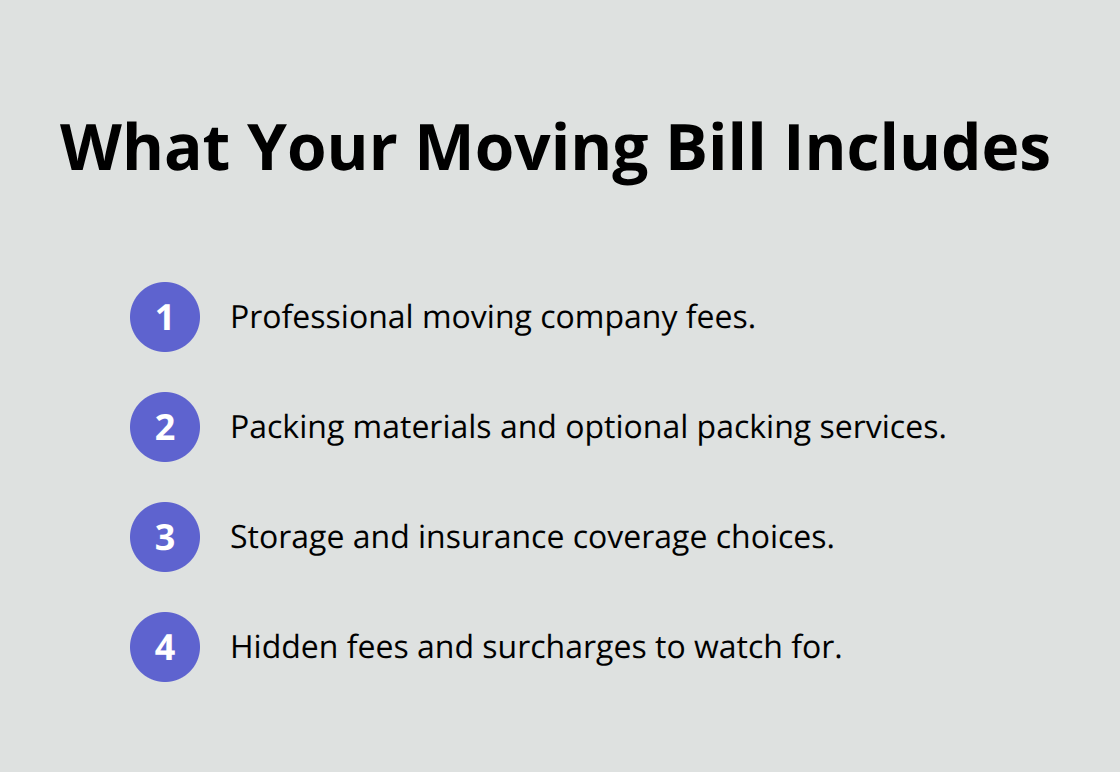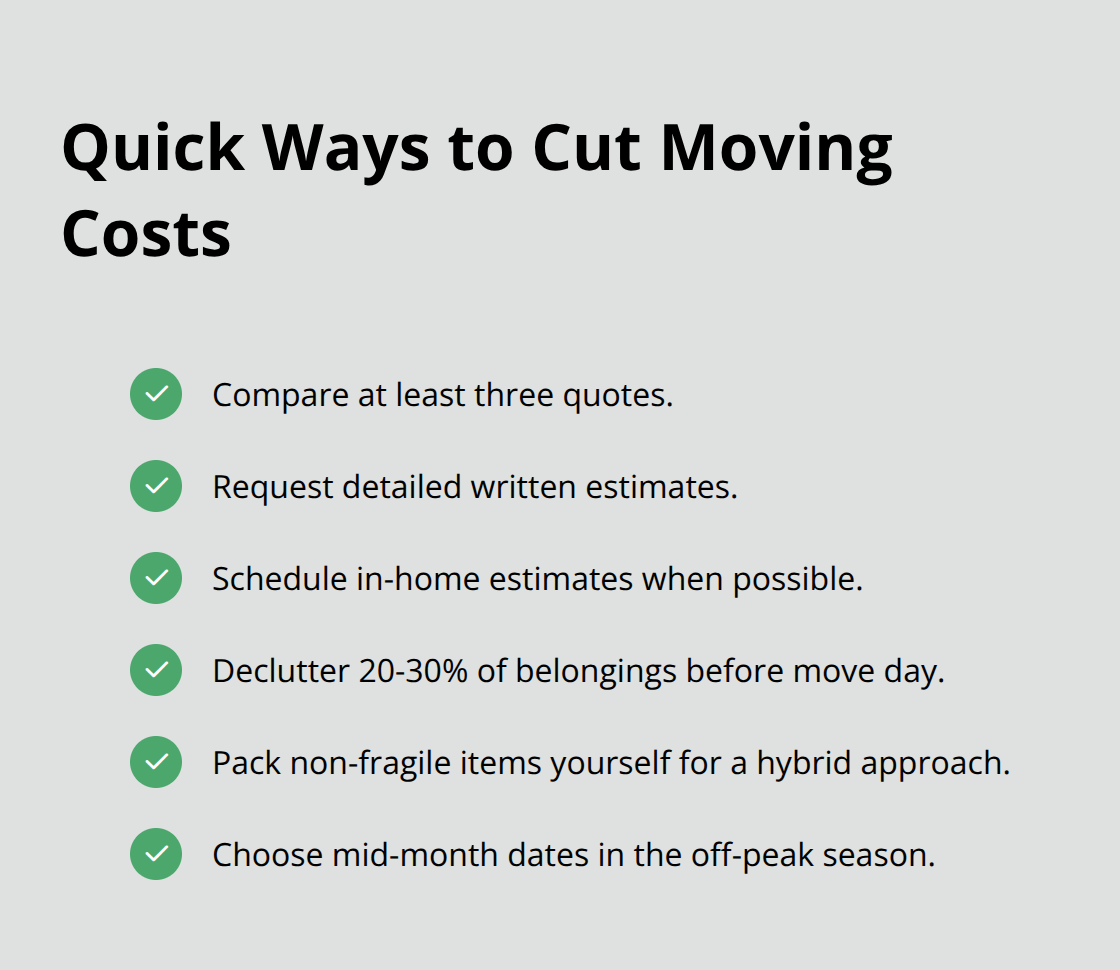Moving house ranks among life’s most expensive events, with the average price for moving house ranging from $800 to $5,000 depending on various factors.
We at Southbay Moving Systems see homeowners struggle with unexpected costs that can double their initial budget. Understanding these expenses upfront helps you plan better and avoid financial surprises on moving day.
What Drives Your Moving Costs
Distance creates the biggest expense difference in any move, with local moves averaging $1,489 while cross-country relocations jump to $4,582 according to industry data. The price difference becomes dramatic when you cross state lines – a 100-mile move costs roughly three times more than a local relocation within the same city. Transportation expenses alone account for up to 60% of your total moving bill, which makes distance the primary cost driver you must consider when you budget.
Weight and Volume Impact Your Bill
Professional movers charge long-distance moves based on weight, typically at rates from $12 to $16 per square foot for home relocations. A one-bedroom apartment that weighs 2,000 to 4,000 pounds averages $2,197 to move, while larger homes can easily double or triple this cost. The number of items directly affects your hourly rate for local moves too – more belongings mean more movers and longer load times, which push your costs from the standard $38 to $75 per hour per mover into higher territory.

Peak Season Drives Prices Up
Summer moves cost significantly more due to peak demand, with rates that drop during winter months when fewer people relocate. Moves on the 1st or 30th of the month increase costs because of apartment lease schedules, while mid-month dates offer better rates and availability. Off-peak dates combined with winter schedules can save you hundreds of dollars, making flexibility your strongest tool when you plan your move timeline.
Special Services Add Extra Costs
Additional services like packing, storage, and specialty item handling can increase your total bill by 30-50%. Professional packing services typically cost $500-$1,500 extra depending on home size, while piano moves add $200-$600 to your quote. Insurance coverage beyond basic protection costs additional fees but protects valuable items during transport. These services affect your final price, which leads us to examine the specific breakdown of all moving expenses.
What Will Your Moving Bill Include
Professional Moving Company Fees
Professional movers charge base rates that start at about $80 per hour per mover for local moves, while long-distance relocations cost $12-$16 per square foot according to Moving.com data. Full-service companies typically require minimum charges of 2-4 hours even for small moves. U-Haul averages $1,778 total while North American Van Lines reaches $3,600 for comparable services.
Labor-only services cost less at $25-$40 per worker per hour, but you handle truck rental and drive yourself. Specialty item fees add $200-$600 for pianos, $100-$300 for hot tubs, and $50-$150 per flight of stairs beyond the first floor.
Packing Materials and Supplies
Packing supplies range from $50-$300 based on home size, with boxes that cost $1-$3 each and bubble wrap that runs $20-$30 per roll. Professional packing services add $500-$1,500 to your bill but save 8-12 hours of work according to industry averages. Most homeowners underestimate material costs (especially for fragile items) and end up making multiple supply runs during their move.
Storage and Insurance Costs
Storage costs $50-$300 monthly for climate-controlled units, while basic moving insurance covers only $0.60 per pound – inadequate for electronics or furniture. Full-value protection covers replacement costs for damaged items in your entire shipment.

Hidden Fees to Watch Out For
Watch for hidden charges like fuel surcharges that add 5-10% to your total, elevator fees of $75-$150, and long-carry charges when trucks cannot park within 75 feet of your door. These unexpected costs catch many homeowners off guard and can push your final bill well above initial estimates, which makes it essential to understand how you can reduce these expenses through smart planning strategies.
How Can You Cut Your Moving Expenses
Compare Quotes From Multiple Companies
Request quotes from at least three different companies to save hundreds of dollars on your move. Quotes for identical moves can vary significantly between companies, with cross-country moves averaging about $4,570 but ranging between $2,389 to $6,869.

Ask for detailed written estimates that break down all costs (labor, transportation, materials, and additional fees). Companies like U-Haul average $1,778 while North American Van Lines reaches $3,600 for comparable services, which demonstrates the massive price variations in this industry. Schedule in-home estimates whenever possible since phone quotes frequently underestimate actual costs by 15-20% according to industry reports.
Remove Items Before Move Day
Declutter before your move to reduce weight and volume, which directly cuts your transportation costs since long-distance moves charge by weight and local moves charge by time. Sell unwanted furniture and appliances to generate cash that offsets expenses while you reduce your shipment size. A typical household can eliminate 20-30% of their possessions through strategic decluttering, which translates to savings of $300-$800 on average moves. Donate items to charity for potential tax deductions, sell valuable pieces online, and dispose of hazardous materials that movers cannot transport anyway.
Handle Your Own Packing Strategy
Self-service moves cost 40-60% less than full-service options according to data from various sources, though they require more personal time and effort. Pack non-fragile items yourself while you leave delicate electronics and artwork to professionals, which creates a hybrid approach that balances cost savings with item protection. Use household items like towels and clothes as padding instead of bubble wrap, and source free boxes from liquor stores, grocery stores, and online marketplaces.
Choose Off-Peak Times
Off-peak seasons see decreased demand and lower rates, while peak seasons experience high demand leading to higher prices. Move between October and April to take advantage of slower seasons when companies compete more aggressively for business. Avoid the 1st and 30th of each month when apartment leases typically begin and end, as these dates create artificial demand spikes that drive up prices across the industry.
Final Thoughts
Distance, weight, timing, and services determine your total expenses when you relocate. Local moves average $1,489 while long-distance relocations reach $4,582, with the average price for moving house spanning from $800 to $5,000 based on your specific requirements. Professional movers charge these rates consistently across the industry.
Advance preparation reduces expenses through off-peak dates, decluttering, and quote comparisons from multiple companies. Professional packing adds $500-$1,500 but protects valuable items, while DIY approaches cut costs by 40-60%. Hidden fees like fuel surcharges and elevator charges surprise homeowners without proper preparation (especially during peak season moves).
We at Southbay Moving Systems provide transparent estimates that help you budget accurately for your relocation. Our team offers professional moving services throughout Central California with detailed cost breakdowns upfront. Contact us for a customized quote that eliminates unexpected expenses from your move.




